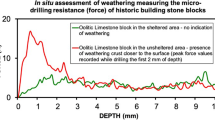Abstract
The “Porta Férrea” (Iron Gate) is the main access to the “Paço das Escolas” (University Palace) at the University of Coimbra, Portugal. It has undergone several adaptations and reconstructions from an original castle gate until the present portal that was built in 1634. The inscription of “University of Coimbra, Alta and Sofia” in the UNESCO Word Heritage list increased the interest in developing conservation works and to do the characterization of the limestone materials of the “Porta Férrea” portal. To support the conservation works, a research project was developed. The intervention plan, the sampling and testing performed and the conservation developed are presented. The rock material in the portal is the Ançã limestone, showing very high porosity around 30%, creating quite important degradation and conservation problems. The deterioration pattern, analyses performed, and the conservative works are presented. In this study it can be confirmed that Ançã limestone of “Porta Férrea” do not decay according a theoretical predictable pattern in response to polluted environments, as the defined for Portland limestone, assuming erosion rates and forms controlled by a range of micro-environment conditions particularly related with architectural constraints.
Similar content being viewed by others
References
Allanbrook T, Wilson A (2012) Conservation of architectural marble at the New York Public Library. In: 12th International congress on the deterioration and conservation of stone Columbia University, New York. http://iscs.icomos.org/pdf-files/NewYorkConf/allawill.pdf. Accessed 11 Feb 2018
Barbosa B, Soares A, Rocha R, Manuppella G, Henriques MH (2008) Carta Geológica de Portugal na escala de 1:50,000. Notícia explicativa da folha 19A—Cantanhede. INETI, Lisboa
Bonifácio H, Gordalina R, Oliveira L, Pessoa L (2006) Paço da Universidade de Coimbra. http://www.monumentos.pt/. Accessed 12 Mar 2016
Bracci S, Sacchi B, Pinto APF, Delgado-Rodrigues J (2008) Inorganic consolidants on stone artefacts: optimisation of application procedures for marble and limestones. In: Delgado Rodrigues J, Mimoso JM (eds) Proceedings of the international symposium “Stone Consolidation in Cultural Heritage. Research and Practice”, Lisbon, LNEC, pp 81–90
Branco JB, Formosinho SJ (1983) pH of rain water in Coimbra, Portugal: the seasonal variation. Tellus 35(B):237–239
Cariati F, Rampazzi L, Toniolo L, Pozzi A (2000) Calcium oxalate films on stone surfaces: experimental assessment of the chemical formation. J Stud Conserv 45(3):180–188. https://doi.org/10.1179/sic.2000.45.3.180
Costa D, Delgado-Rodrigues J (2012) Consolidation of a porous limestone with nanolime. In: 12th International congress on deterioration and conservation of stone, at New York (USA), November 2012. https://www.researchgate.net/publication/257919278. Accessed 6 Mar 2014
De Kock T et al (2012) Monitoring frost susceptibility of limestone facies. In: 12th International congress on the deterioration and conservation of stone Columbia University, New York. http://iscs.icomos.org/pdf-files/NewYorkConf/dekoetal1.pdf. Accessed 11 Feb 2018
Delgado-Rodrigues J, Ferreira Pinto AP (2015) Laboratory and onsite study of barium hydroxide as a consolidant for high porosity limestones. J Cult Heritage 19:467–476. https://doi.org/10.1016/j.culher.2015.10.002
Doehne E, Price C (2010) Stone conservation: an overview of current research, 2nd edn. Getty Conservation Institute, Los Angeles. https://doi.org/10.1007/s12665-016-5661-y
EN 13755 (2006) Natural stone test methods—determination of real density and apparent density, and of total and open porosity. European standard
EN 1936 (2008) Natural stone test methods—determination of water absorption at atmospheric pressure. European Standard
Ferreira Pinto AP, Delgado-Rodrigues J (2008) Stone consolidation: the role of treatment procedures. J Cult Heritage 9:38–53. https://doi.org/10.1016/j.culher.2007.06.004
Ferreira Pinto AP, Delgado-Rodrigues J (2012) Consolidation of carbonate stones: influence of treatment procedures on the strengthening action of consolidants. J Cult Heritage 13:154–166. https://doi.org/10.1016/j.culher.2011.07.003
Fitzner B, Heinrichs K, La Bouchardiere D (2002) Limestone weathering of historical monuments in Cairo Egypt. In: Siegesmund S, Weiss T, Vollbrecht A (eds) Natural stone, weathering phenomena, conservation strategies and case studies, vol 205. Geological Society, London, pp 217–239 (Special Publications)
Foxboro (1999) Conductivity ordering guide. EXW Foxboro, Massachusetts. http://myweb.wit.edu/sandinic/Research/conductivity%20v%20concentration.pdf. Accessed 15 Feb 2018
Giordani P, Modenesi P, Tretiach M (2003) Determinant factors for the formation of the calcium oxalate minerals, weddellite and whewellite, on the surface of foliose lichens. Lichenologist 35(3):255–270. https://doi.org/10.1016/S0024-2829(03)00028-8
Graue B, Siegesmund S, Simon K, Licha T, Oyhantcabal P, Middendorf B (2012) Environmental impact on stone decay: crust formation at the Cologne cathedral. In: 12th International congress on the deterioration and conservation of stone Columbia University, New York. http://iscs.icomos.org/pdf-files/NewYorkConf/grauetal1.pdf. Accessed 11 Feb 2018
Graue B, Siegesmund S, Oyhantcabal P, Naumann R, Licha T, Simon K (2013) The effect of air pollution on stone decay: the decay of the Drachenfels trachyte in industrial, urban, and rural environments—a case study of the Cologne, Altenberg and Xanten cathedrals. Environ Earth Sci 69:1095–1124. https://doi.org/10.1007/s12665-012-2161-6
Hayashi M (2004) Temperature–electrical conductivity relation of water for environmental monitoring and geophysical data inversion. Environ Monit Assess 96(1–3):119–128
Hughes T, Lott GK, Poultney MJ, Cooper B (2013) Portland Stone: a nomination for "Global Heritage Stone Resource" from the United Kingdom. Episodes 36(3):221–226
ICOMOS-ISCS (2008) Illustrated Glossary on Stone Deterioration Patterns. In: International council on monuments and sites/international scientific committee for stone. Edition V. Vergès-Belmin. Monuments and Sites XV, English-French edition
IGUC (2016) Normal climatological and actinometric values 1971–2000. Instituto Geofísico da Universidade de Coimbra. http://www1.ci.uc.pt/iguc/dados_cllima/norm7100.htm. Accessed 29 Oct 2016
INETI (2017) Catalogue of Portuguese Ornamental Stones, RS-CA 601 Ançã = Pedra de Ançã; RS-CA 601b Pedra de Outil. http://rop.lneg.pt/rop/index_en.php. Accessed 6 May 2017
Marques F (2013) Conservação e Restauro da Porta Férrea, Paço das Escolas. Internal document GNI/GCU, Universidade de Coimbra
McAlister JJ, Smith BJ, Neto JAB (2000) The Presence of Calcium Oxalate Dihydrate (Weddellite) in street sediments from Niterói, Brazil and its Health Implications. Environ Geochem Health 22:195. https://doi.org/10.1023/A:1026593729453
Oudbashi O, Siapoosh B, Siapoosh M, Shekofte A (2008) Consolidation of Limestone by Lime Method in Sangneveshteh Historic Monument, Khoramabad, West of Iran—a Practical Case. In: Delgado Rodrigues J, Mimoso JM (eds) Proceedings international symposium “Stone Consolidation in Cultural Heritage. Research and Practice”, Lisbon, LNEC, pp 289–297
Pamplona M, Kocher M, Snethlage R, Wendler E (2008) Consolidation effectiveness of TEOS on Ançã limestone from Portugal—a laboratory study. In: Delgado Rodrigues J, Mimoso JM (eds) Proceedings international symposium “Stone Consolidation in Cultural Heritage. Research and Practice”, Lisbon, LNEC, pp 183–192
Pio CA, Ramos MM, Duarte AC (1998) Atmospheric aerosol and soiling of external surfaces in an Urban Environment. Atmos Environ 32(11):1979–1989
Rusakov AV, Kuzmina M, Frank-Kamenetskaya O, Vlasov D (2017) Crystallization medium variations as a factor of oxalate patina formation. IUCr 2017 E-Abstracts. http://eabstracts.iucr2017.org/. Accessed 15 Feb 2018
Schiavon N, (2002) Biodeterioration of calcareous and granitic building stones in urban environments, vol 205. Geological Society, London, pp 195–205. https://doi.org/10.1144/GSL.SP.2002.205.01.15 (Special Publications)
Segurado JES (1932) Materiais de Construção. Biblioteca de Instrução Profissional. Livrarias Aillaud e Bertrand, 2ª edn
Silveira A, Lima JLMP, Lima MIP, Silva GCO, Naspolini BF (2016) Análise comparativa da qualidade da água da chuva precipitada e coletada em coberturas em dois locais no Brasil e em Portugal. Engenharia Civil UM 52:23–32
Smith BJ, Gomez-Heras M, Viles HA (2010) Underlying issues on the selection, use and conservation of building limestone. In: Smith BJ, Gomez-Heras M, Viles HA, Cassar J (eds) Limestone in the built environment: present-day challenges for the preservation of the past, vol 331. Geological Society, London, pp 1–11. https://doi.org/10.1144/SP331.1 (Special Publications)
Smith BJ, McCabe S, McAllister D, Adamson C, Viles HA, Curran JM (2011) A commentary on climate change, stone decay dynamics and the ‘greening’ of natural stone buildings: new perspectives on ‘deep wetting’. Environ Earth Sci 63:1691–1700. https://doi.org/10.1007/s12665-010-0766-1
Tidblad J et al (2012) Effects of air pollution on materials and cultural heritage: ICP materials celebrates 25 years of research. Int J Corros. https://doi.org/10.1155/2012/496321
Trindade MF, Ferreira MOQ, Oliveira R (1998) Contribution to the study of Ancã limestone. In: Moore D, Hungr O (eds) Eighth international congress international association for engineering, geology and the environment, proceedings, vol 1–5, pp 2945–2952
University of Coimbra (2016) University of Coimbra Alta and Sofia—world heritage list. http://worldheritage.uc.pt/. Accessed 20 Oct 2016
Urosevic M, Yebra-Rodríguez A, Sebastián-Pardo E, Cardell C (2012) Black soiling of an architectural limestone during two-year term exposure to urban air in the city of Granada (S Spain). Sci Total Environ 414:564–575
Wadsten T, Moberg R (1985) Calcium oxalate hydrates on the surface of lichens. Lichenologist 17(3):239–245 https://doi.org/10.1017/S0024282985000305 (Published online: 28 March 2007)
Watt J, Jarrett D, Hamilton R (2008) Dose–response functions for the soiling of heritage materials due to air pollution exposure. Sci Total Environ 400(1–3):415–424
Wilhelm K, Viles H, Burke O, Mayaud J (2016) Surface hardness as a proxy for weathering behaviour of limestone heritage: a case study on dated headstones on the Isle of Portland, UK. Environ Earth Sci 75:931
Yates T (2007) Results from the 2005–2006 trend exposure program. Corrosion attack of limestone after 1 year exposure, vol 8. Building research Establishment Ltd., Garston. http://www.corr-institute.se/ICP-Materials. Accessed 19 Feb 2018
Zornoza-Indart A, López-Arce P, Gómez-Villalba LS, Varas-Muriel MJ, Fort R (2012) Consolidation of deteriorated carbonate stones with Ca(OH)2 nanoparticles. In: 12th International congress on the deterioration and conservation of stone Columbia University, New York. http://iscs.icomos.org/pdf-files/NewYorkConf/zornoza.pdf. Accessed 11 Feb 2018
Acknowledgements
We thank AOF Lda company (Dr. Telma Teixeira and David Llanos) for the information provided. Access to TAIL-UC facility, funded under QREN-Mais Centro project ICT_2009_02_012_1890 is gratefully acknowledged. This work was supported by FCT—Fundação para a Ciência e a Tecnologia, I.P., through Portuguese funds, in the research project UID/Multi/00073/2013 of the Geosciences Center of the University of Coimbra.
Author information
Authors and Affiliations
Corresponding author
Additional information
This article is part of a Topical Collection in Environmental Earth Sciences on “Stone in the Architectural Heritage: from quarry to monuments—environment, exploitation, properties and durability”, guest edited by Siegfried Siegesmund, Luís Sousa, and Rubén Alfonso López-Doncel.
Rights and permissions
About this article
Cite this article
Catarino, L., Gil, F.P.S.C., Quinta-Ferreira, M. et al. Characterization and rehabilitation of the “Porta Férrea” stone materials, University of Coimbra, Portugal. Environ Earth Sci 77, 416 (2018). https://doi.org/10.1007/s12665-018-7587-z
Received:
Accepted:
Published:
DOI: https://doi.org/10.1007/s12665-018-7587-z













